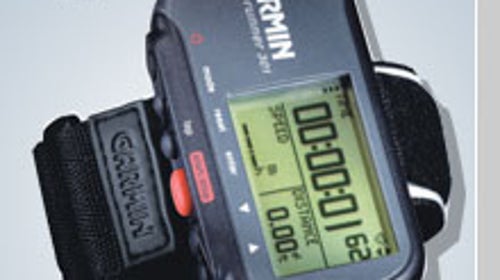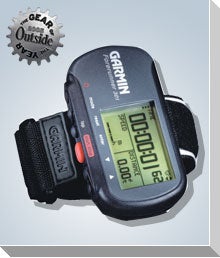Leave it to the GPS pros at Garmin to thoroughly idiot-proof heart-rate training: The company’s new Forerunner 301—our pick for Gear of the Year—is a no-brainer digital coach. It’s ideal for runners, trekkers, cyclists, paddlers, and anyone else who wants to collect satellite-enhanced workout data in the field and crunch the numbers later.
1. After charging up the Forerunner, I fastened it to my wrist, donned the heart-rate strap, walked outside, and—while the device searched for GPS satellites—programmed in my height, weight, age, and sex. Total setup time: five minutes. On subsequent runs, the 301 found a bird in a mere 30 seconds.
2. Like all high-end heart-rate monitors, the 301 doubles as a watch, altimeter, speedometer, and odometer. But count your blessings, real-time-feedback junkies, because while most screens let you see only three types of data at once, the Forerunner’s displays four. Your heart rate pops up in the top-right corner.
3. Program a target pace or speed into the Virtual Partner screen and “race” against yourself. It’s an ideal feature for goal-oriented training, such as running a sub-three-hour marathon. Every second, the 301 tells you exactly how far you are behind—or ahead of—yourself.
4. This navigation company didn’t forget its roots. The Forerunner is a legit waterproof GPS that will direct you back to the trailhead, turn by turn, should you become deliriously lost on an all-day speed hike. Just try to do so before its ten-hour rechargeable battery expires.
5. The included USB cable syncs the Forerunner with a PC and unleashes the Training Center software, which graphs your heart’s workload. I ran it with Garmin MapSource ($117, sold separately) to reveal my bike route on a street map, then clicked on the corresponding heart-rate graph to see the exact point where I almost reached cardiac arrest.


